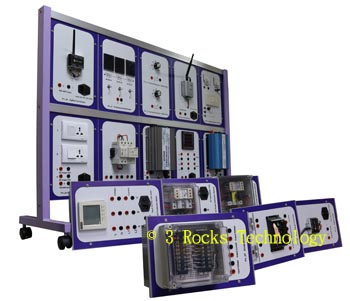Comprehensive Solar Energy Training System: CSE-35422
Features:
The system explores solar as an energy source that can be used to help reduce not only carbon footprint but also the dependence on non-renewable fuel sources. Students can gain a comprehensive understanding on converting solar energy to electricity.
Covered experiments
Section I.: Introduction to diode
Measurement of characteristic curves of diode
1.1 Introduction to diodes
1.1 Measurement of characteristic curves of a single silicon diode.
1.2 Measurement of characteristic curves of silicon diodes in series.
Section II: Power Generation Principle
Measurement of characteristic curves of solar modules
2.1 Measurement of characteristic curves of solar module.
2.2 Measurement of characteristic curves of solar module under different illuminations.
2.3 Measurement of characteristic curves of solar module under different temperatures.
2.4 Measurement of power output of solar module under different tilt angles.
2.5 Measurement of power generation of summer days and winter days.
Experiment of small-watt solar panel
3.1 The shading phenomenon of solar photovoltaic modules without bypass diodes.
3.2 The shading phenomenon of solar photovoltaic modules with bypass diodes.
Section III: Power Generation Systems
Independent solar power generation system
4.1 Build a small parallel solar power generation system.
4.2 Measurement of converter efficiency.
Solar power controller
5.1 Create a small solar power generation system.
5.2 Measurement of converter characteristic curves
5.3 PWM on battery charging
Parallel solar power generation system
6.1 Understand parallel power generation principle and structure.
6.2 Measurement of power conversion and power output.
Hybrid power generation system
7.1 Understand hybrid power generation principle and structure.
7.2 Understand the hybrid power generation operating principle.
Section IV: Monitoring Technologies
Wired Monitoring
8.1 Utilize USB and RS-485 for to connect the power system and computer.
8.2 System data collection and data analysis.
8.3 System error alarm
Wireless monitoring
9.1 ZigBee p-to-p wireless communication
9.2 Wireless network Analysis
9.3 Measurement of wireless network analyzer packets
9.4 System data collection and data analysis.
9.5 System error alarm
10.1 Network communication through WiFi.
10.2 Data collection through WiFi
10.3 Data Analysis
10.4 System error alarm
Section V: Simplified Smart Network
11.1 Home appliance controlled through RS-485
11.2 Home appliance controlled through ZigBee
11.3 Home appliance controlled through WiFi
